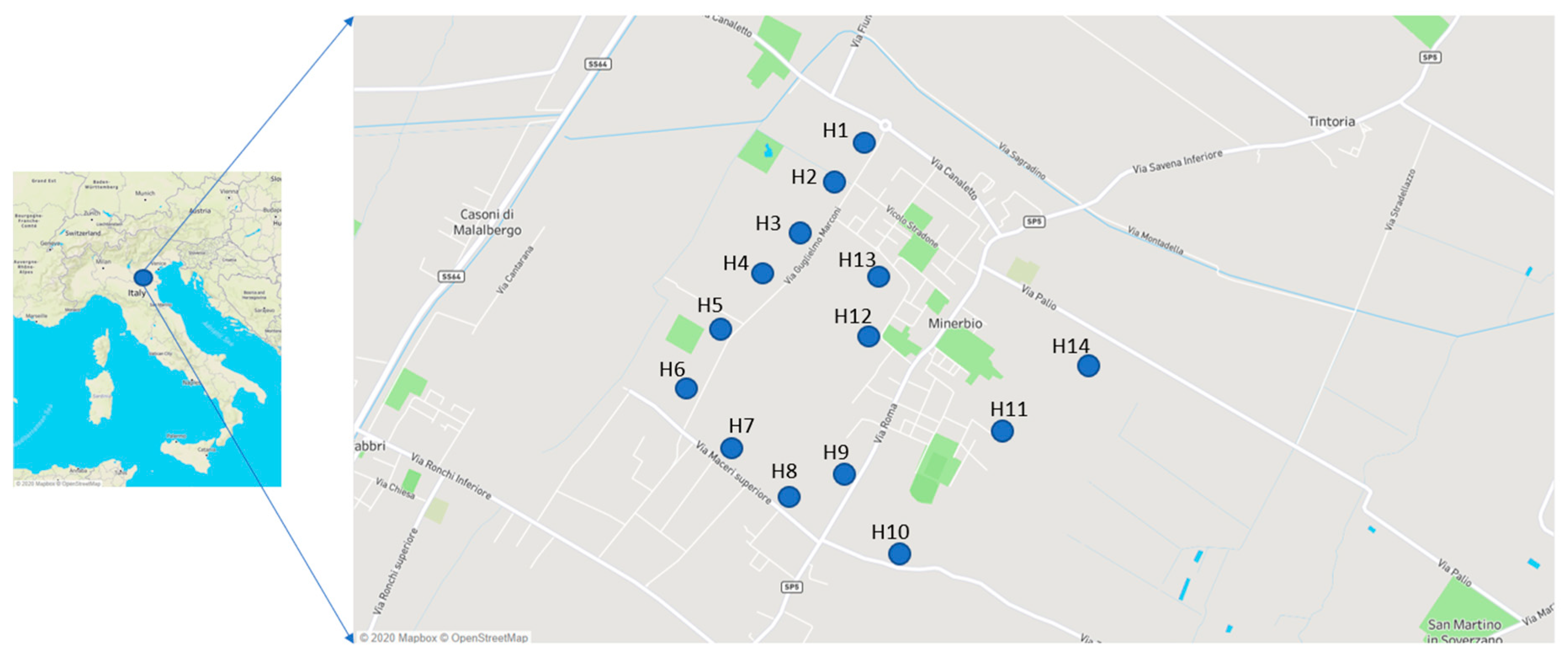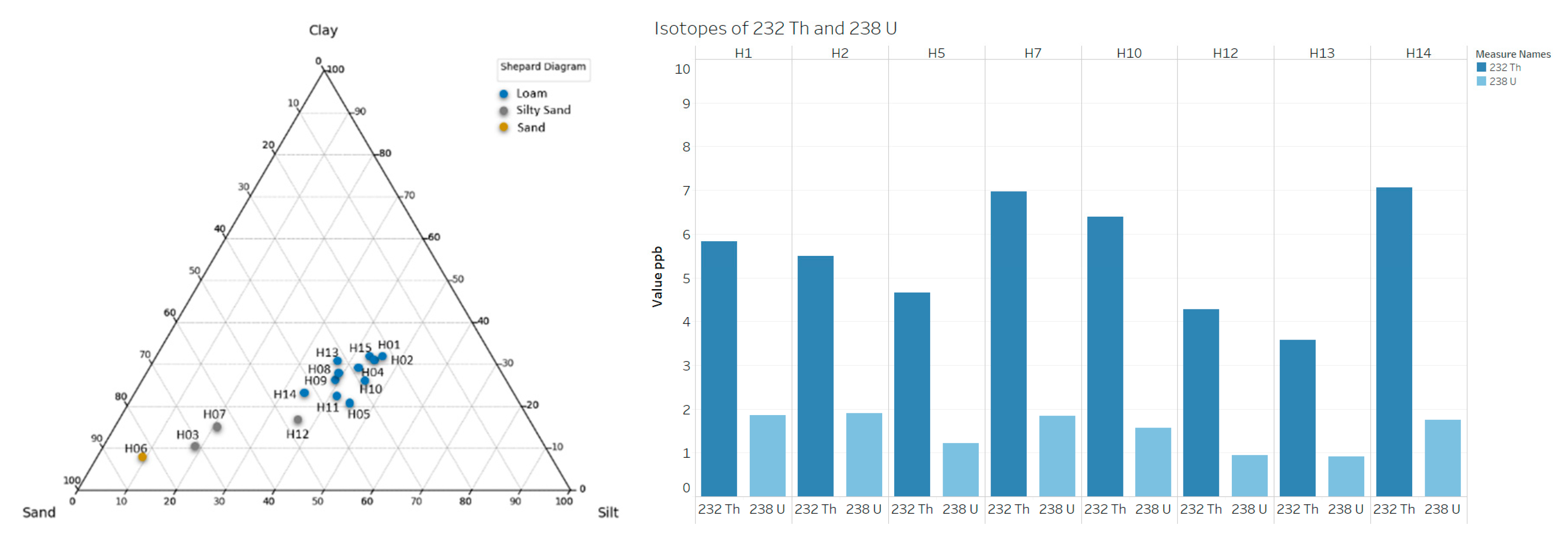Atmospheric and Soil Methane Concentrations Integrating a New Gas Detection Technology †
Abstract
1. Introduction
2. Material and Methods
3. Results and Discussion
3.1. Soil Analysis
3.2. Soil Gas Survey
4. Conclusions
Funding
Acknowledgments
Conflicts of Interest
References
- Bachu, S.; Celia, M.A. Assessing the Potential for CO2 Leakage, Particularly Through Wells, from Geological Storage Sites, Carbon Sequestration and Its Role in the Global Carbon Cycle. AGU Monogr. 2009, 183, 203–216. [Google Scholar]
- Benson, S. Carbon Dioxide Capture and Storage: Assessment of Risks from Storage of Carbon Dioxide in Deep Underground Geological Formations. In Workshop Proceedings, The 10–50 Solution: Technologies and Policies for a Low-Carbon Future; The Pew Center on Global Climate Change and the National Commission on Energy Policy; Lawrence Berkeley National Laboratory: Berkeley, CA, USA, 2006. [Google Scholar]
- Conley, S.; Franco, G.; Faloona, I.; Blake, D.R.; Peischl, J.; Ryerson, T.B. Methane emissions from the 2015 Aliso Canyon blowout in Los Angeles, CA. Science 2016, 351, 1317–1320. [Google Scholar] [CrossRef] [PubMed]
- Kang, M.; Kanno, C.M.; Reid, M.C.; Zhang, X.; Mauzerall, D.L.; Celia, M.A.; Chen, Y.; Onstott, T.C. Direct measurements of methane emissions from abandoned oil and gas wells in Pennsylvania. Proc. Natl. Acad. Sci. USA 2014, 111, 18173–18177. [Google Scholar] [CrossRef] [PubMed]
- Rigby, M.; Prinn, R.G.; Fraser, P.J.; Simmonds, P.G.; Langenfelds, R.L.; Huang, J.; Cunnold, D.M.; Steele, L.P.; Krummel, P.B.; Weiss, R.F.; et al. Renewed growth of atmospheric methane. Geophys. Res. Lett. 2008, 35, 22805. [Google Scholar] [CrossRef]
- Nordbotten, J.M.; Kavetski, D.; Celia, M.A.; Bachu, S. Model for CO2 Leakage Including Multiple Geological Layers and Multiple Leaky Wells. Environ. Sci. Technol. 2009, 43, 743–749. [Google Scholar] [CrossRef] [PubMed]
- Kunzli, N.; Kaiser, R.; Medina, S.H.; Studnicka, M.; Chanel, O.; Filliger, P.; Herry, M.; Horak, F.; Puybonnieux-Texier, V.; Quenel, P.; et al. Public-health impact of outdoor and traffic-related air pollution: A European assessment. Lancet 2000, 356, 795–801. [Google Scholar] [CrossRef]
- Romanak, K.D.; Bennett, P.; Yang, C.; Hovorka, S.D. A process-based approach to CO2 leakage detection by vadose zone gas monitoring at geologic CO2 storage sites. Geophys. Res. Lett. 2012, 39. [Google Scholar] [CrossRef]
- Lombardi, S.; Etiope, G.; Guerra, M.; Ciotoli, G.; Grainger, P.; Duddridge, G.A.; Gera, F.; Chiantore, V.; Pensieri, R.; Grindrod, P.; et al. The Refinement of Soil Gas Analysis as a Geological Investigative Technique; Final Report; Work Carried Out under A Cost-Sharing Contract with the European Atomic Energy Community in the Framework of its 4th R&D Program on ‘Management and Storage of Radioactive Waste’ (1990–1994) Part A, Task 4: ‘Disposal of Radioactive Waste’. EUR 16929 EN; European Commission: Luxembourg, 1996; ISBN 92-827-7838-X. [Google Scholar]
- Abdoh, A.; Pilkington, M. Radon emanation studies of the Ile Bizard Fault, Montreal. Geoexploration 1989, 25, 341–354. [Google Scholar] [CrossRef]
- Wilkening, M. Radon transport processes below the Earth’s surface. In The Natural Radiation Environment, III; Tech. Inf. Center, U.S. Dept. of Energy: Springfield, VA, USA, 1980; pp. 90–104. [Google Scholar]
- Durrance, E.M.; Gregory, R.G. Helium and radon transport mechanisms in hydrothermal circulation systems of Southwest England. In Geochemistry of Gaseous Elements and Compounds; Theophrastus Publ.: Athens, Greece, 1990; pp. 337–352. [Google Scholar]
- Folk, R.L.; Ward, W.C. A Study in the Significance of Grain-Size Parameters. J. Sediment. Petrol. 1957, 27, 3–26. [Google Scholar] [CrossRef]
- Wentworth, C.K. A Scale of Grade and Class Terms for Clastic Sediments. J. Geol. 1922, 30, 377–392. [Google Scholar] [CrossRef]
- Inubushi, K.; Furukawa, Y.; Hadi, A.; Purnomo, E.; Tsuruta, H. Seasonal changes of CO2, CH4 and N2O fluxes in relation to land-use change in tropical peatlands located in coastal area of South Kalimantan. Chemosphere 2003, 52, 603–608. [Google Scholar] [CrossRef]
- Inubushi, K.; Wada, H.; Takai, Y. Determination of microbial biomass nitrogen in submerged soil. Soil Sci. Plant Nutr. 1984, 30, 455–459. [Google Scholar] [CrossRef][Green Version]
- Ziska, L.H.; Moya, T.B.; Wassmann, R.; Namuco, O.S.; Lantin, R.S.; Aduna, J.B.; Abao, E.; Bronson, K.F.; Neue, H.U.; Olszyk, D. Long-term growth at elevated carbon dioxide stimulates methane emission in tropical paddy rice. Glob. Chang. Biol. 1998, 4, 657–665. [Google Scholar] [CrossRef]
- Hooker, P.J.; Bannon, M.P. Methane: Its Occurrence and Hazards in Construction; Construction Industry Research and Information Association R130: London UK, 1993; 140p. [Google Scholar]
- Fey, A.; Conrad, R. Effect of Temperature on Carbon and Electron Flow and on the Archaeal Community in Methanogenic Rice Field Soil. Appl. Environ. Microbiol. 2000, 66, 4790–4797. [Google Scholar] [CrossRef] [PubMed]
- Ambus, P.L.; Robertson, G.P. Fluxes of CH4 and N2O in aspen stands grown under ambient and twice-ambient CO2. Plant Soil 1999, 209, 1–8. [Google Scholar] [CrossRef]
- Phillips, R.; Whalen, S.C.; Schlesinger, W.H. Response of soil methanotrophic activity to carbon dioxide enrichment in a North Carolina coniferous forest. Soil Biol. Biochem. 2001, 33, 793–800. [Google Scholar] [CrossRef]
- Dijkstra, F.A.; Morgan, J.A.; LeCain, D.R.; Follett, R.F. Microbially mediated CH4 consumption and N2O emission is affected by elevated CO2, soil water content, and composition of semi-arid grassland species. Plant Soil 2009, 329, 269–281. [Google Scholar] [CrossRef]
- Drolet, J.-P.; Martel, R.; Poulin, P.; Dessau, J.-C.; Lavoie, D.; Parent, M.; Lévesque, B. An approach to define potential radon emission level maps using indoor radon concentration measurements and radio geochemical data positive proportion relationships. J. Environ. Radioact. 2013, 124, 57–67. [Google Scholar] [CrossRef] [PubMed]
- Nazaroff, W.W. Radon transport from soil to air. Rev. Geophys. 1992, 30, 137–160. [Google Scholar] [CrossRef]
- Etiope, G.; Martinelli, G. Migration of carrier and trace gases in the geosphere: An overview. Phys. Earth Planet. Inter. 2002, 129, 185–204. [Google Scholar] [CrossRef]
- Ilie, A.M.; Vaccaro, C. Design of a smart gas detection system in areas of natural gas storage. In Proceedings of the 2017 IEEE International Geoscience and Remote Sensing Symposium (IGARSS), Fort Worth, TX, USA, 23–28 July 2017; pp. 5954–5957. [Google Scholar]




Publisher’s Note: MDPI stays neutral with regard to jurisdictional claims in published maps and institutional affiliations. |
© 2020 by the authors. Licensee MDPI, Basel, Switzerland. This article is an open access article distributed under the terms and conditions of the Creative Commons Attribution (CC BY) license (https://creativecommons.org/licenses/by/4.0/).
Share and Cite
Ilie, A.M.C.; Vaccaro, C. Atmospheric and Soil Methane Concentrations Integrating a New Gas Detection Technology. Proceedings 2020, 67, 7. https://doi.org/10.3390/ASEC2020-07564
Ilie AMC, Vaccaro C. Atmospheric and Soil Methane Concentrations Integrating a New Gas Detection Technology. Proceedings. 2020; 67(1):7. https://doi.org/10.3390/ASEC2020-07564
Chicago/Turabian StyleIlie, Ana Maria Carmen, and Carmela Vaccaro. 2020. "Atmospheric and Soil Methane Concentrations Integrating a New Gas Detection Technology" Proceedings 67, no. 1: 7. https://doi.org/10.3390/ASEC2020-07564
APA StyleIlie, A. M. C., & Vaccaro, C. (2020). Atmospheric and Soil Methane Concentrations Integrating a New Gas Detection Technology. Proceedings, 67(1), 7. https://doi.org/10.3390/ASEC2020-07564




